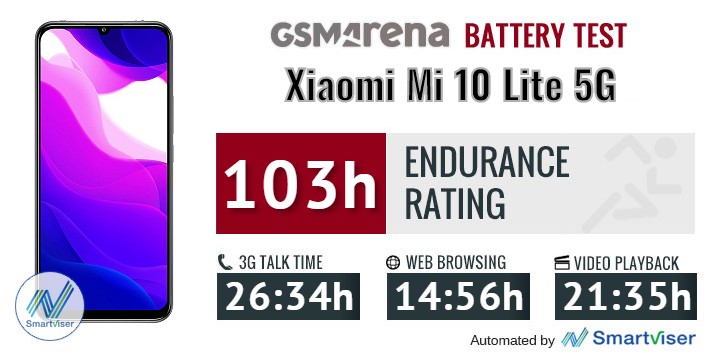Introduction
The least expensive 5G smartphone you can buy in Europe, the Mi 10 Lite 5G was launched at a base price of €350, showing that next-gen connectivity doesn't have to require shelling out flagship money. We're reviewing it a couple of months after the initial release and it can now even be found for a little less than that, keeping its title in the face of the just announced Moto G 5G Plus - Motorola's most affordable point of entry into 5G.

So what is Xiaomi giving you for that price, other than high speed data transfers and improved latency, in a few lucky spots here and there? The 5G support comes courtesy of a potent Snapdragon 765G chipset, but the base version comes with just 64GB of storage and with no microSD slot that could be limiting (the 6 gigs of RAM should be just fine). The camera setup is nothing fancy, a 48MP main unit joined by a basic 8MP ultra wide and a couple of 2MP cams for close ups and depth detection.
The display leaves a little to be desired on paper too - it's a large FullHD+ OLED with HDR10+ capability, which is all great, but there's no high refresh rate. The battery capacity could potentially raise an eyebrow, the lowest of the current crop of 5G midrangers, though the 4,160mAh number would have sounded a lot just a year ago. The 20W charging support is also hardly impressive.

But Xiaomi has put together a very well balanced specsheet within a seemingly impossible budget and you can't have everything at the Mi 10 Lite 5G's price point. Here's a rundown of the specs, before we move on to examining how they translate into real-world performance.
Xiaomi Mi 10 Lite 5G specs
- Body: 163.7x74.8x7.9mm, 192g; Gorilla Glass 5 front and back, plastic frame. Colors: Aurora Blue, Cosmic Gray, Dream White.
- Display: 6.57" AMOLED, 1080x2400px resolution, 20:9 aspect ratio, 401ppi; HDR10+.
- Chipset: Qualcomm SDM765 Snapdragon 765G (7 nm): Octa-core (1x2.4 GHz Kryo 475 Prime & 1x2.2 GHz Kryo 475 Gold & 6x1.8 GHz Kryo 475 Silver); Adreno 620.
- Memory: 64GB 6GB RAM, 128GB 6GB RAM, 256GB 8GB RAM.
- OS/Software: Android 10, MIUI 11.
- Rear camera: Wide (main): 48 MP, f/1.8, 26mm, 1/2.0", 0.8µm, PDAF; Ultra wide angle: 8 MP, f/2.2, 15mm, 120˚, 1/4.0", 1.12µm; Macro: 2 MP, f/2.4; Depth: 2 MP, f/2.4; Dual-LED flash, HDR, panorama.
- Front camera: 16 MP, f/2.5, (wide), 1/3.06", 1.0µm; HDR, panorama.
- Video capture: Rear camera: 4K@30/60fps, 1080p@30/60/120/240/960fps, gyro-EIS; Front camera: 1080p@30fps, 720p@120fps.
- Battery: 4160mAh; Fast charging 20W, USB Power Delivery 3.0, Quick Charge 4+.
- Misc: Fingerprint (under display, optical), accelerometer, gyro, proximity, compass; NFC.
Xiaomi Mi 10 Lite 5G unboxing
The Mi 10 Lite 5G comes in a black cardboard box like all them other Mi 10s and Mi 10 Notes. Inside, you'll get a fairly typical Xiaomi bundle - adapter, cable and a case, no headphones.

The adapter is rated at up to 22.5W, though the phone is specified to support 20W charging - more on charging speed in the battery section. It's got a USB-A port so the cable is a matching A-to-C type. The case is a soft silicone one, transparent too.
Design
The Mi 10 Lite 5G may be a Mi 10, but its Lite DNA is also fairly prominent. For starters, it's missing the metal frame that the Mi 10 and Mi 10 Pro have, a feature also found on the Mi Note 10 and, in fact, even the Mi Note 10 Lite. It's made of plastic here and while it's not an inherently bad material for a smartphone as we've said time and time again, for all its practical benefits, it's not quite as premium.

Another notable difference when looking at the Mi 10 lineup is the camera cluster on the back the Mi Note 10 Lite 5G. Where all the others have their cameras arranged vertically, this Lite 5G opts for a 2x2 layout. The camera assembly sticks out a good millimeter and if you are to type a lot of Qs and Ws with the phone lying on a table, it will wobble slightly, otherwise it's pretty stable.
 Mi 10s: Pro (left) next to the Lite
Mi 10s: Pro (left) next to the Lite
Xiaomi doesn't explicitly specify the material used on the back of the Mi 10 Lite 5G, but good guy Corning has the phone listed in the 'Is it on yours' section - Gorilla Glass 5 it is, front and back. Our review unit is in the Cosmic Gray colorway, the least exciting of the bunch. Aurora Blue and Dream White are the other options and both offer a bit more personality.

The front of the phone continues with the somewhat nondescript look. The 6.57-inch AMOLED display takes up most of it, naturally, surrounded by relatively thin black borders on the sides, marginally thicker top bezel, and a bit more sizeable chin. It's not a screen-to-body ratio marvel, the Mi 10 Lite, but it's not bad either.

There's a selfie camera notch in the middle of the display's top edge, a waterdrop style, if we're still labeling those. It's a small cutout and the fluid shape helps make it less obtrusive than sharper designs. You can hide it in settings by making the status bar black if the several years of notched phones haven't made you desensitized to this otherwise unattractive design element.
Above the camera, there's a long meshed slit where the earpiece is located. It's really just the leftmost third of it or so that has openings, the rest of it is just for show.

This being an OLED panel, Xiaomi has fitted it with an under-display fingerprint reader. It's the optical variety and it works as expected from a modern optical sensor - quickly and reliably.
The mechanical controls on the Mi 10 Lite 5G are on the right side of the phone. The power button is just above the midpoint, the volume rocker is above it. The buttons are plastic too but click nicely and their relatively close proximity didn't strike us as an issue in use.

The USB-C port is on the bottom of the phone, the primary mic and the loudspeaker to its right, the card tray on the left. The card tray on our dual SIM review unit will take up to two nano SIMs, but no microSD - the Mi 10 Lite does not support memory expansion.
Up top, you'll find the 3.5mm headphone jack and an extra mic, but also the IR blaster - we're happy that Xiaomi remains committed to the feature.



Buttons on the right • Card tray is on the bottom • Headphone jack, IR emitter and a mic up top
The Mi 10 Lite 5G measures 163.7x74.8x7.9mm and weighs 192g - middle of the road numbers for footprint and heft as 5G mid-tier phones go. The Moto G 5G Plus is the heaviest at 207g, the more premium LG Velvet is the lightest at 180g. The Xiaomi is one of the thinnest, with the Velvet matching it, but others being up to 1.4mm thicker (the Motorola Edge) The Galaxy A51 5G is the shortest at 158.9mm, but at 8.7mm it's a thicker than the Mi 10 Lite 5G.

Properly good AMOLED display
The Mi 10 Lite 5G uses a 6.57-inch AMOLED display, seemingly the same one found on the Redmi 10X and 10X Pro. It's a 0.1" bigger diagonal than the 6.47-inch panels on the Mi Note 10 family. The increase comes from the slightly stretched aspect ratio - the Mi 10 Lite 5G's display has a resolution of 1080x2400px in a 20:9 aspect, compared to the 1080x2340px 19.5:9 units used on the Mi Note 10s. A minor increase in density sees that number go up to 401ppi, 398ppi on the 6.47-inch displays.

6.57 or 6.47 inches, midrange Xiaomi AMOLED displays are in the same ballpark when it comes to brightness, and that applies to most other OLEDs in the segment as well. We measured 610 nits with the phone in auto brightness mode and the ambient light sensor under direct light and 442nits with the auto toggle in its off state.
On top of the usual manual and auto modes, there's also a sunlight mode. It's available only when the auto toggle is disabled, and it effectively lets you control the brightness manually most of the time, but the phone will auto boost it in very bright ambient conditions only - to the same level as in the auto mode.
| Display test | 100% brightness | ||
| Black, |
White, |
||
| 0 | 442 | ∞ | |
| 0 | 610 | ∞ | |
| 0 | 424 | ∞ | |
| 0 | 596 | ∞ | |
| 0 | 405 | ∞ | |
| 0 | 617 | ∞ | |
| 0 | 410 | ∞ | |
| 0 | 642 | ∞ | |
| 0 | 416 | ∞ | |
| 0 | 595 | ∞ | |
| 0 | 518 | ∞ | |
| 0 | 848 | ∞ | |
| 0 | 516 | ∞ | |
| 0 | 854 | ∞ | |
| 0 | 379 | ∞ | |
| 0 | 520 | ∞ | |
| 0 | 510 | ∞ | |
| 0 | 819 | ∞ | |
There are all sorts of color settings on the Mi 10 Lite 5G. In the Color scheme menu, you can choose between the default Auto mode, Saturated mode, and Original color mode, each of these having Default/Warm/Cool options and a color wheel for further tweaking that manually.
And because that may not be enough, there's also an Advanced settings submenu, with four additional presets (Enhanced/Original/P3/sRGB) and RGB sliders, Hue, Saturation, and Value sliders, and Contrast and Gamma sliders. Sliders galore. Too many sliders, in fact. Thankfully, there's a 'Restore defaults' button, for when you realize you've changed more than you'd like.

In the out-of-the-box Auto mode, we measured an average dE2000 of 3.6 when examining out DCI-P3 test swatches. That improved to 2.3 when going for the pre-set Warm mode, and nudging the point on the color wheel a little bit, we got to a 1.9 average. Saturated mode returned virtually the same results.
Original color mode got us an average dE2000 of 2.1 for sRGB test swatches, which was way better than we got out of the Advanced>sRGB profile (3.8 average). Advanced>P3 was also less accurate to the DCI-P3 targets than the plain Auto mode (4.5 vs. 3.6 average dE2000).





Display settings • Sunlight mode • Color settings • Maximum DCI-P3 accuracy • Advanced settings
The Mi 10 Lite 5G's display is HDR10-capable. We tried Netflix, Amazon Prime Video, and YouTube, and all three happily served HDR content to the phone.
The one thing this display is missing, is a high refresh rate - it's capped at 60Hz. Admittedly that would have been too much to ask on the phone that was launched as the most affordable 5G handset in the western world at €350 and is now a few bucks cheaper.
Xiaomi Mi 10 Lite 5G battery life
The Mi 10 Lite 5G relies on a 4,160mAh battery, a relatively small number for a 5G-capable midranger. The Galaxy A51 5G has a bit higher capacity at 4,500mAh, while the recently announced Moto G 5G Plus packs a more sizeable 5,000mAh cell. Pricier 5G models also have a few extra mAhs - the Motorola Edge stands at 4,500mAh, the LG Velvet is the closest to the Mi 10 Lite 5G with its 4,300mAh battery.
Having said that, the Mi 10 Lite 5G posted properly excellent results in our standard testing. The 15-hour result in web browsing is only matched by the Galaxy A51 5G (14:30h), while the Velvet (12:19h) and the Edge (12:52h) are noticeably behind, if not too shabby themselves. With upwards of 21 hours of looping videos, the Mi 10 Lite 5G is out of reach for even the Galaxy (18:35h), the Moto Edge trails another hour behind (17:29h) and the Velvet (15:37h) is least binge-watching-friendly. All of these are more than solid numbers, but the Xiaomi's stand out as even solid-er, despite the lowest capacity of the bunch.
3G voice calls on the Mi 10 Lite 5G returned a 26:34h result, again beating the Galaxy (22:15h) and the Velvet (24:53h), but well short of the Moto Edge's nearly 40 hours (which is an excessive amount of talk time if you ask us). We haven't tested the Moto G 5G Plus yet to include in these comparisons.
In the end, the Mi 10 Lite 5G posted an overall Endurance rating of 103h.

Our battery tests were automated thanks to SmartViser, using its viSer App. The endurance rating above denotes how long a single battery charge will last you if you use the Xiaomi Mi 10 Lite 5G for an hour each of telephony, web browsing, and video playback daily. We've established this usage pattern so that our battery results are comparable across devices in the most common day-to-day tasks. The battery testing procedure is described in detail in case you're interested in the nitty-gritty. You can check out our complete battery test table, where you can see how all of the smartphones we've tested will compare under your own typical use.
The included charger that's rated at 9V/2.23A, 12V/1.67A, and 10V/2.25A, tops up the Mi 10 Lite 5G in 1:16h from flat, with 55% on the battery indicator at the half-hour mark. While not strictly super-fast, those are, in a way, class-leading numbers - the Galaxy A51 5G takes 1:30 for a full charge, the Velvet needs 1:59h, while the Moto Edge requires precisely double the time that the Mi 10 Lite 5G needs.
There's no wireless charging capability on the Mi 10 Lite 5G, the Mi 10 and Mi 10 Pro do get that. Of the bunch we've been mentioning above, only the Velvet has the induction coils, but it does cost double the Mi 10 Lite 5G's price.
Speaker test
The Mi 10 Lite 5G is equipped with a single loudspeaker on the bottom, same as the regular Mi Note 10 and the Mi Note 10 Lite. It's the same concept at least, as the Mi 10 Lite 5G has distinctly better sounding output with some semblance of bass to it and clarity the other non-flagship Mis can't muster. In terms of loudness, the Mi 10 Lite 5G is in their 'Average' ballpark, however.

Use the Playback controls to listen to the phone sample recordings (best use headphones). We measure the average loudness of the speakers in LUFS. A lower absolute value means a louder sound. A look at the frequency response chart will tell you how far off the ideal "0db" flat line is the reproduction of the bass, treble, and mid frequencies. You can add more phones to compare how they differ. The scores and ratings are not comparable with our older loudspeaker test. Learn more about how we test here.
Audio output quality
We've recently discontinued our audio output quality test.
The reason for that is that most phones that arrived for testing were already excellent in this regard and whatever difference there was, it was marginal and probably indistinguishable to anything but our lab equipment.
The usual pairing of Android 10 and MIUI 11
The Mi 10 Lite 5G runs MIUI 11, based on Android 10, a combination we've seen on a ton of recent Xiaomi phones. They do differ here and there, but for the most part MIUI is identical between devices running the same major version.

The Mi 10 Lite 5G features an Always-on display, and you can schedule it or leave it on/off all the time. MIUI 11 has a ton of themes you can choose from and make it yours and some of them can even be further customized. The AOD also supports breathing light - the edges of the display will flash with colors upon new notifications. It's not as cool as on one of the curved edge phones in the lineup (like the Mi Note 10 Lite), but at least it won't be an incentive to leave your phone face down.






AOD and notification edge LED effects
In terms of biometric security, the Mi 10 Lite 5G gives you a choice between face and fingerprint unlock. The fingerprint reader would be our top choice as it works quickly and reliably. Facial recognition isn't as secure, but if you're after convenience it'll deliver that.
We do appreciate the extra attention to detail Xiaomi put into the visual aspects of unlocking as there are plenty of fingerprint reader animations to choose from. Better still, there are a couple of fingerprint-reader-based shortcuts you can set up for some extra convenience.






Security • Fingerprint setup • Fingerprint shortcuts • Animations • Face recognition
As far as the general layout goes, you get a few nice little extras, like a quick shortcuts pane to the left of the lock screen. In there, you can arrange and control your Mi Remote and IoT gadgets and appliances and also toggle the flashlight.
This particular build also features an app drawer option, which was missing on the Mi 10 and 10 Pro we reviewed but was to be found on the Mi Note 10s we had at the office. It's the same one introduced by the off-shoot Poco Launcher, which has now made it to non-Poco-specific MIUI versions. It's a very custom solution that sorts apps by categories, though you can move stuff around and you can also just scroll the All apps list.






Lock screen • Quick access pane • Home screen • Folder view • App drawer
The similarly unorthodox card-based task switcher can take some time to adjust but offers all of the needed functionality. Multi-window is a bit clunky, requiring you to tap a split-screen button and then drag an app towards the top when simply dragging an app towards the already empty top could have gotten the job done. It's not a better in the native Android implementation anyway.





Recent apps • Split screen • Quick return to split screen • Notifications pane • Quick toggles
On the mi Note 10 Lite 5G, similarly to other Xiaomi phones with MIUI11, navigation is handled in the classic three-button nav-bar manner out of the box. A gesture-based method is available, naturally, and switching to that is the first thing we do on any phone. It's missing the thin bar on the bottom that's become the Android 10 default way for switching back and forth between apps. On MIUI, switching between the last two apps is done by swiping from the edge of a screen as if you are performing a back gesture and holding for a split second. If you are not fond of that quick switch, you can disable it in the settings menu.
You can also hide the display notch in one of two ways, either leaving the status icons in the black portion or shifting them down into the usable area.





Navigation options • Notch hiding
A system-wide Dark mode is also available, and by now Xiaomi's ironed out the imperfections we observed on the Mi 10, where we even found the occasional Xiaomi app and menu that doesn't adhere to Dark Mode settings.
You get extensive theme support with MIUI. Basically, everything is subject to change including wallpapers, icons, fonts, the lot.
MIUI also offers a Security app. It can scan your phone for malware, manage your blacklist, manage or restrict your data usage, configure battery behavior, and free up some RAM. It can also manage the permissions of your installed apps, allows you to define the battery behavior of selected apps and applies restrictions only to the apps you choose.
A set of proprietary multimedia apps are on board too - Gallery, Music, and Video player. In some regions, the music and video apps include paid streaming options. MIUI 11 has a new document viewing app, which supports all popular formats and makes for a seamless experience. Mi Remote is also available for controlling legacy non-connected appliances with the IR blaster, and an FM radio app lets you listen to musing over the airwaves - record it too, but it doesn't support RDS, so you'll need to name the stations manually.






Security app • Gallery • Video • Music • FM radio • Mi Remote
Synthetic benchmarks
The Mi 10 Lite 5G runs on the Snapdragon 765G platform, Qualcomm's midrange 5G-capable chipset. It's manufactured on a 7nm production process and features a built-in modem unlike the flagship S865.
The CPU has a 1+1+6 configuration with a Prime core clocked at up to 2.4GHz, a Gold core limited to 2.2GHz (both of these Cortex-A76 derivatives) and 6 Cortex-A55-based Silver cores with a top speed of 1.8GHz. The GPU is called Adreno 620. The Mi 10 Lite 5G comes in three RAM and storage configurations - 6/64GB, 6/128GB, and 8/256GB, and we have the mid-tier variant.

The CPU-focused GeekBench puts the Mi 10 Lite 5G at the top of the chart in the multi-core test, all other S765G devices (and the Exynos 980 Galaxy A51 5G) a small distance behind. In the single-core test, the Galaxy does pull ahead, but the Mi still manages to outperform the S765 crew. Assorted Snapdragon 720 and 730 devices are almost there, but not quite - also, no 5G capability on those.
GeekBench 5.1 (multi-core)
Higher is better
- Xiaomi Mi 10 Lite 5G
1927 - LG Velvet
1905 - Samsung Galaxy A51 5G
1867 - Motorola Edge
1862 - Oppo Reno3 Pro 5G
1815 - Xiaomi Redmi Note 9S
1785 - Xiaomi Redmi Note 9 Pro
1785 - Realme X2
1750 - Samsung Galaxy A71
1733 - Motorola One Fusion+
1705 - Xiaomi Mi Note 10 Lite
1694 - Xiaomi Redmi K30
1692 - Xiaomi Redmi Note 9
1292
GeekBench 5.1 (single-core)
Higher is better
- Samsung Galaxy A51 5G
677 - Xiaomi Mi 10 Lite 5G
616 - Oppo Reno3 Pro 5G
609 - Motorola Edge
586 - LG Velvet
586 - Xiaomi Redmi Note 9 Pro
571 - Xiaomi Redmi Note 9S
570 - Xiaomi Redmi K30
548 - Realme X2
545 - Samsung Galaxy A71
542 - Motorola One Fusion+
542 - Xiaomi Mi Note 10 Lite
521 - Xiaomi Redmi Note 9
361
Antutu, too, puts the Mi 10 Lite 5G in the lead, barely inching ahead of the Galaxy. The Xiaomi also beast the Reno3 Pro 5G, Motorola Edge and LG Velvet - so another first place among the S765 devices we've tested.
AnTuTu 8
Higher is better
- Xiaomi Mi 10 Lite 5G
318117 - Samsung Galaxy A51 5G
316007 - Oppo Reno3 Pro 5G
308231 - Motorola Edge
305989 - LG Velvet
297372 - Xiaomi Redmi Note 9 Pro
279625 - Xiaomi Redmi K30
272229 - Motorola One Fusion+
267980 - Samsung Galaxy A71
263396 - Realme X2
257443 - Xiaomi Redmi Note 9S
254000 - Xiaomi Mi Note 10 Lite
253271 - Xiaomi Redmi Note 9
200414
The top-class performance continues in graphics benchmarks, where the Mi 10 Lite 5G leads the charts.
GFX 3.1 Manhattan (1080p offscreen)
Higher is better
- Oppo Reno3 Pro 5G
38 - Xiaomi Mi 10 Lite 5G
38 - Motorola Edge
34 - LG Velvet
33 - Samsung Galaxy A51 5G
32 - Xiaomi Redmi Note 9 Pro
31 - Xiaomi Redmi K30
30 - Samsung Galaxy A71
30 - Xiaomi Mi Note 10 Lite
30 - Xiaomi Redmi Note 9S
30 - Realme X2
29 - Motorola One Fusion+
27
GFX 3.1 Manhattan (onscreen)
Higher is better
- Motorola Edge
32 - Oppo Reno3 Pro 5G
32 - Xiaomi Mi 10 Lite 5G
32 - LG Velvet
29 - Samsung Galaxy A51 5G
28 - Xiaomi Redmi K30
27 - Samsung Galaxy A71
27 - Xiaomi Mi Note 10 Lite
26 - Xiaomi Redmi Note 9S
26 - Xiaomi Redmi Note 9 Pro
26 - Motorola One Fusion+
25 - Realme X2
24
GFX 3.1 Car scene (1080p offscreen)
Higher is better
- Oppo Reno3 Pro 5G
21 - Xiaomi Mi 10 Lite 5G
21 - Samsung Galaxy A51 5G
20 - Motorola Edge
19 - LG Velvet
19 - Xiaomi Redmi Note 9S
18 - Xiaomi Redmi Note 9 Pro
18 - Xiaomi Redmi K30
17 - Samsung Galaxy A71
17 - Xiaomi Mi Note 10 Lite
17 - Realme X2
16 - Motorola One Fusion+
16
GFX 3.1 Car scene (onscreen)
Higher is better
- Motorola Edge
18 - Oppo Reno3 Pro 5G
18 - Xiaomi Mi 10 Lite 5G
17 - Samsung Galaxy A51 5G
17 - LG Velvet
16 - Xiaomi Redmi K30
15 - Samsung Galaxy A71
15 - Xiaomi Mi Note 10 Lite
15 - Xiaomi Redmi Note 9S
15 - Xiaomi Redmi Note 9 Pro
15 - Motorola One Fusion+
14 - Realme X2
13
3DMark SSE OpenGL ES 3.1 1440p
Higher is better
- Xiaomi Mi 10 Lite 5G
3294 - Oppo Reno3 Pro 5G
3214 - Motorola Edge
3004 - LG Velvet
2987 - Samsung Galaxy A51 5G
2837 - Xiaomi Redmi Note 9 Pro
2497 - Xiaomi Redmi Note 9S
2494 - Xiaomi Redmi K30
2467 - Xiaomi Mi Note 10 Lite
2467 - Samsung Galaxy A71
2464 - Realme X2
2402
3DMark SSE Vulkan 1440p
Higher is better
- Xiaomi Mi 10 Lite 5G
3080 - Oppo Reno3 Pro 5G
2995 - Motorola Edge
2801 - Samsung Galaxy A51 5G
2778 - LG Velvet
2758 - Xiaomi Redmi Note 9S
2357 - Xiaomi Redmi Note 9 Pro
2356 - Realme X2
2263 - Samsung Galaxy A71
2253 - Xiaomi Mi Note 10 Lite
2248 - Xiaomi Redmi K30
2244
The Mi 10 Lite 5G turned in performance numbers that can be described as best among equals. A few units ahead of competitors in multi-core GeekBench and a hair more than the next one in Antutu will be just as inconsequential as the occasional extra frame per second in graphics benchmarks. It does feel good to know that Xiaomi has squeezed the most out of the available hardware.
A Lite-er camera setup
The Mi 10 Lite 5G has more of a Redmi-ish camera system - it covers the basics without offering anything too fancy. The main module on the back uses the ubiquitous 48MP Tetracell sensor from Samsung (Quad Bayer in Sony speak), paired with a 26mm f/1.8 lens. There's an ultra wide angle camera too - with a modest 8MP sensor and an f/2.2 aperture lens that should cover a 120-degree field of view.
There's a total of 4 cams on the Mi 10 Lite 5G's back and to get to that number you need to count a couple of 2MP units. One of them is the depth sensor that can't take pictures on its own, but instead only assists in portraits. The other one is a slightly more useful 'macro' cam for taking close-ups, and you do so at varying (short) subject distances as it has autofocus.

For selfies, the Mi 10 Lite 5G uses a rather common cam in Xiaomi's lineup - a 16MP f/2.5 fixed focus unit. It's the same one you'd find on the Mi Note 10 Lite and the Poco M2 Pro, to name just a couple.
As we've witnessed time and time again, Xiaomi's camera app looks and feels mostly the same, regardless of module count and specifics. You swipe from side to side to change modes, but a bit of a nuisance is that you can only switch by one mode at a time - so, for example, going from Photo mode to Night mode requires three separate swipes, instead of one long one. You can also tap on the modes that you can see to switch to those directly, though they don't all show up on one screen. Up and down swipes don't work for switching between the front and rear cameras, only the toggle next to the shutter release does that.
On the near end of the viewfinder, you have the rear camera switch that operates in one of two fashions. The first one is simply tapping on the circle with the active magnification to cycle between the main cam's native view (1x), a digitally zoomed in 2x, and the 0.6x for the ultra-wide. Alternatively, you can tap on the respective dots for direct access to each magnification.
On the opposite end of the viewfinder, you have a flash mode switch (Off/Auto/On/Torch/Soft light), an HDR switch (Off/Auto/On), an AI toggle, the macro mode shortcut and a magic wand with beauty effects and filters. Behind a hamburger menu, you'll find some more options plus the shortcut to the full settings menu.

There's a nicely capable Pro mode, where you can tweak shooting parameters yourself. You get to pick one of 4 white balance presets or dial in the light temperature with a slider, there's a manual focusing slider (arbitrary units 0-100), and shutter speed and ISO control with ranges depending on which camera you're using. You can access both the main cam and the ultra wide, as well as the macro module, while in Pro mode. Behind the A button up top, you can select between focus peaking and zebras for overexposure, but a live histogram is missing. A metering mode selector is available too.
Image quality
The Mi 10 Lite 5G's daylight photos from the main cam are very nice. They are sharp and detailed and noise is not obtrusive in any way, though there is some of it if you look closely. Colors are rendered a notch livelier than real life, an approach we don't mind. Dynamic range is respectably wide, though if we were to nitpick in this respect we'd appreciate a bit more development in the shadows.








Daylight samples, main cam, 12MP
Turning on the 'AI camera' will result in the phone supposedly recognizing some scene types and tweaking image parameters accordingly. In practice, you'd be getting out-of-this-world saturated colors and much contrastier tone curve crushing detail in both tonal extremes. We'd avoid that.




Daylight samples, main cam, 12MP, AI camera on
As is customary, the Mi 10 Lite 5G can also shoot in the main cam's nominal 48MP resolution. Going that route will net you a bit more resolved detail in good light, though images have a specific hazy dreamy soft look to them. Noise gets more prominent too.




Daylight samples, main cam, 48MP
What's anything but customary is the Mi 10 Lite 5G's 1x/2x toggle in 48MP mode. So you you can have digitally zoomed in 2x 48MP shots. Here are a few for your viewing pleasure.



Daylight samples, main cam, 48MP, 2x zoom
The 2x mode in 12MP resolution makes more sense. The images are reasonably detailed though not as good as ones from a dedicated tele cam. Still, they'll do in a pinch.
The ultra wide angle cam of the Mi 10 Lite 5G is no match for the main shooter in resolution or dynamic range, but fares decently all things considered. It captures good detail for its 8MP and renders colors in a similar fashion to the main cam.








Daylight samples, ultra wide cam
There's software distortion correction applied to the above images and it's a setting that comes switched on out of the box. Unless you want the bulging look for artistic reasons, the correction is best left on.




Distortion correction: On • Off • On • Off
Low-light performance on the Mi 10 Lite 5G is par for the course for the segment. Shots from the main cam are on the soft side, dynamic range is narrow and underexposure is a common sight. Colors are decently retained, though this Mi is one of those phones that throws a strong orange cast on warmly lit images like the first sample.
Night mode helps with dynamic range, lifts the shadows slightly and salvages some of the highlights - it's not a dramatic change, but it's a noticeable and appreciated one. In our experience, night mode shots turned out sharper and less noisy, too.







Low-light samples, main cam, Night mode
2x zoom shots are okay - with phones, particularly in the midrange, still often defaulting to a zoomed in view from the main cam even when there is a telephoto, the Mi 10 Lite 5G sort of competes on a level playing field. Naturally, detail at 1:1 magnification isn't impressive, but confined to fit-to-screen use, the 2x photos will do.
Since it's the main cam taking these pictures, and there's Night mode on the main cam, there's Night mode for 2x zoom too. The improved tonal development in the extremes can be seen too, alongside some heavy handed sharpening. Once again - usable results, not remarkable.




Low-light samples, 2x zoom, Night mode
Darkness renders the ultra wide angle camera of the Mi 10 Lite 5G nearly useless. Underexposure is common and with the camera not getting enough light, the images end up soft and noisy.




Low-light samples, ultra wide cam
Portrait mode
The Mi 10 Lite 5G has a reasonably capable Portrait mode. Subject detection is mostly good, with no issues along the border between subject and background, whether it's the person's head or clothes. The default blur level makes for a nicely natural-looking effect too. HDR is available in portraits and the phone does expose prioritizing for faces.
One slight niggle we have is that the preview in the viewfinder is not always accurate and it shows non-blurred areas that should be blurred - they do end up correctly rendered in the final image, it's just that you're often left wondering whether you'd get the right results while shooting.
Portrait mode works on non-human subjects too. Results are generally very good, though straight lines in the background can sometimes have an artificial kinda-sharp-kinda-blurry look.




Portrait samples, non-human subjects
Close-ups
The Mi 10 Lite 5G's 'macro' cam allows you to shoot close-ups at varying short distances thanks to the autofocus, which comes in handy. The photos look mightily impressive on the phone's display as you're taking them, but further examination on a larger screen reveals there's not all that much detail. Dynamic range is pretty limited too.
Selfies
The Mi 10 Lite 5G's selfies turn out alright. They have decent level of detail, but with sharpening applied through the roof, they have a particularly overprocessed look. It is, quite surprisingly, a very different rendition to the one we got out of the Mi Note 10 Lite, which should have the same hardware. Colors are on point on this Mi while dynamic range may not be stellar, but it's fairly wide and it works nicely with the phone's tendency to bias exposure for the faces in the frame.
Selfie portraits have some weird imperfections along the borders between subject and background - around clothes but also around faces, more than what we're used to from recent phones. You'd be wise to play around with the backgrounds if you want well separated selfie portraits, and multiple shots are always a good idea in order to get one just right.
Video recording
The Mi 10 Lite 5G records video up to 4K at 30fps with its main cam and 1080p at 30fps with its ultra wide module. 2x zoom is also available, sourced from the main 48MP cam. The default codec used is h.264, but you can opt for h.265 and save space if you're shooting a ton of videos.
4K footage from the main cam (42Mbps) has a good level of resolved detail and little noise to speak of. It's a bit too contrasty for our liking and we'd prefer better developed shadows. Colors are vibrant without overdoing it, no complaints there. Switching to 1080p at 30fps (19.5Mbps) results in a grittier texture, Xiaomi overdid the sharpening there, but it's not the worst offender. 1080p at 60fps (same 19.5Mbps) is actually processed more conservatively and looks more natural and thus more appealing to us. The dark shadows remain a sore spot in 1080p at both frame rates.
There's a 2x zoom mode for video as well. 4K footage doesn't stand up to pixel level scrutiny quite as well as it does in its native zoom level, but still manages to look sharper than 2x 1080p when viewed fullscreen. If 1080p is your jam, the 2x zoom capture comes with comparable quality to 1x videos.
As is commonly the case, the ultra wide angle cam's footage has narrower dynamic range and that extra bit of saturation, compared to the main shooter. It maxes out at 1080p 30fps and looks easily good enough, as ultra wide 1080p goes.
Video stabilization is available in all 30fps modes on both cams, including the 2x zoom level. 1080p at 60fps gets no EIS, however. Videos come out remarkable stable when shooting at the 1x and 0.6x setting while walking. Staying in one place and shooting at the 2x zoom level produces very stable footage too. Pans are also handled with no issues at all.
Competition
The Mi 10 Lite 5G's top competitor is shaping up to be the Moto G 5G Plus - another 5G-capable smartphone from the bargain bin, matching the Mi's €350 list price. That one's still on its way to us, so we can't be sure how it performs, but looking at the specsheets alone, the Moto will have you sacrifice OLED in favor of 90Hz, and we're leaning towards the Mi's OLED on this one. The G 5G Plus will also give you a second, ultra-wide, selfie cam, and that's nice to have.

The Huawei P40 Lite 5G (mind the 5G in the name, it's important) retails for about €50 more than the Mi 10 Lite 5G. This one too has an LCD, but without even the HRR going for it, we can safely say the Mi 10 Lite 5G has the superior panel, though we haven't seen the Huawei. The P40 Lite 5G does come with 128GB of storage and an expansion slot, but we're hardly fans of its almost-proprietary NM standard. The 64MP main cam is probably a bit better than the Mi's, but there's the tiny caveat that the P40 Lite 5G has no Google Play Services support. We're leaning strongly towards the Xiaomi in this bout.
The Galaxy A51 5G is the next most affordable phone with 5G connectivity support (Google services included too), and it comes in at a good €100 more than the Mi 10 Lite 5G. That will give you twice the storage than what the base version of the Xiaomi phone has, with a microSD slot on the Galaxy on top of that making it the better choice for big libraries of stuff. The Mi has, oddly enough, a slightly better display, but also slightly longer battery life, with a bit faster charging, and a superior speaker - small victories that add up.
That's pretty much the affordable 5G models accounted for. If you're willing to splurge, you could drop about two Mi 10 Lite 5Gs worth of money for an LG Velvet. It's a decidedly more premium handset, and with the more premium looks, you'd also be getting an IP68 rating. Once again, 128GB of base storage and a microSD slot put the Velvet ahead in terms of room for content, and the stereo speakers make for a more enjoyable content gobbling experience too. Still, the Mi 10 Lite 5G is massively better value for money than the LG.




Motorola Moto G 5G Plus • Huawei P40 lite 5G • Samsung Galaxy A51 5G • LG Velvet
Verdict
Starting with a properly excellent display and the longest battery life in the class, the Mi 10 Lite 5G has a solid foundation. On top of that, it builds with a good camera experience, and less discriminating users may be just fine without a telephoto. Sure, low-light performance isn't stellar, and selfies aren't up to scratch, but neither is dealbreakingly bad. Add some MIUI software goodness and little niceties like the IR blaster and the FM radio, and it's a versatile midranger that makes a ton of sense.

The Mi 10 Lite 5G claim to fame was bringing next-gen connectivity support at a low price. That it manages to achieve just fine, the numbers don't lie. But it's also a nice phone outside of that magical 5G and comes with our recommendation.
Pros
- 5G on the cheap.
- One of the best displays for the money.
- Class-leading battery life, fast charging.
- Good daylight image quality, excellent video stabilization.
- MIUI is nicely polished, updates come in quickly.
- Rarely seen set of niceties - 3.5mm jack, FM radio, IR blaster.
Cons
- No telephoto camera.
- Unremarkable camera performance in low light.
- Selfies could be better.
- No microSD slot.











































No comments:
Post a Comment